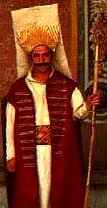 Janissaries (in Turkish "Yeni" means "new" and "Çeri" means "soldier"), standing Ottoman Turkish army, were organized either by the sultan Orhan Gazi or Murat I. Ottoman armies had previously been composed of Turcoman tribal levies, who were loyal to their clan leaders, but as the Ottoman Empire acquired the characteristics of a State, it became necessary to have paid troops loyal only to the sultan. Therefore, the system of impressing Christian kids taken during invasions of countries (known as "devşirme") was instituted and having been converted to Islam and given the finest training, they became the elite forces of the army and the most disciplined and dedicated fighting machine the world had seen up until that time.
Janissaries (in Turkish "Yeni" means "new" and "Çeri" means "soldier"), standing Ottoman Turkish army, were organized either by the sultan Orhan Gazi or Murat I. Ottoman armies had previously been composed of Turcoman tribal levies, who were loyal to their clan leaders, but as the Ottoman Empire acquired the characteristics of a State, it became necessary to have paid troops loyal only to the sultan. Therefore, the system of impressing Christian kids taken during invasions of countries (known as "devşirme") was instituted and having been converted to Islam and given the finest training, they became the elite forces of the army and the most disciplined and dedicated fighting machine the world had seen up until that time.
For the first 200 years of their existence, the Janissaries were responsible for the great expansion of the Ottoman Empire. Special laws regulated their daily life cutting them off from civil society such as being forbidden to marry. Devotion to such discipline made the Janissaries the scourge of Europe. These standards, however, changed with time; recruitment became lax (Moslems were admitted, too) and because of the privileges Janissaries started to enjoy their life, their numbers increased from about 20,000 in 1574 to some 135,000 in 1826. To supplement their salaries, the Janissaries began to pursue various trades and established strong links with civil society, thus undermining their loyalty to the ruler. In time they became kingmakers and the allies of conservative forces, opposing all reforms and refusing to allow the army to be modernized. When they revolted in 1826, Sultan Mahmut II abolished the corps, putting all opposition down by force. Thousands were killed in the Hippodrome and others banished, but most were simply absorbed into the general population.
Apart from the Janissaries, in 1389 Ottoman Army introduced a system of conscription; when needed, every town and village should provide a fully equipped conscript at the recruiting office created by the order of the sultan. This new force of irregular infantrymen was called "Azabs" and they were used in many ways; to build roads and bridges for the army, to support the supplies to the front-line, and sometimes they were even used as cannon fodder to slow down enemy advance. "Başibozuk" was a branch of the "Azabs" and were especially recruited from homeless and criminals. They were fiercefull and undisciplined, specialized in close combat.
Other divisions of the Ottoman Army were:
- Sipahi: an Ottoman cavalryman
- Akaga: White eunuch of the sultan's palace to guard the core area
- Akincilar: a mounted corps of the Ottoman Army used as an advance guard and for raiding
- Mehter Band: used to play military marches during military campaigns and was usually associated with the janissary corps

